As the Bundesliga unfolds its gripping narrative, the upcoming clash between VfB Stuttgart and Bayer Leverkusen stands as a pivotal moment in the season. Scheduled for a Sunday kickoff at 3:30 pm German time in the vibrant city of Stuttgart, this showdown promises high-stakes football between two teams vying for supremacy. Both teams are on Champions League course with only 5 points between them, and FC Bayern sitting in second place in the table.
The clash not only pits two formidable teams against each other but also showcases a tactical duel between two young coaches. Sebastian Hoeneß, steering the ship for VfB Stuttgart, and Xabi Alonso, the strategic mind behind Bayer Leverkusen, bring both youth and tactical sophistication to the touchline.
This tactical analysis in the form of a match preview delves into the intricacies of their coaching styles, the strengths and weaknesses of the respective teams, and the tactics that might shape the outcome of this Bundesliga spectacle. As the footballing world turns its gaze to Stuttgart, anticipation builds for a clash that promises not only points on the table but also a tactical chess match between two of the league’s emerging coaching talents.
Initial situation & line-ups
VfB Stuttgart’s home prowess has been remarkable, securing victories in their last three matches across all competitions and maintaining an unbeaten streak in 17 of their last 20 games. Notably, in their previous 14 home fixtures, they found the net in every outing and managed to score at least two goals in their last eight home league games. Positioned third in the Bundesliga, they’ve amassed an impressive 30 points from 13 matches, boasting ten victories and only three defeats.
Stuttgart faces availability challenges with Hiroki Ito, Lilian Egloff, and Nikolas Nartey ruled out, and uncertainty surrounds the participation of Laurin Ulrich and Roberto Massimo. The potential line-up, adopting a 4-4-2 formation, might feature Alexander Nübel in goal, supported by a defensive line comprising Maximilian Mittelstädt, Dan-Axel Zagadou, Waldemar Anton, and Pascal Stenzel. The midfield could see Chris Führich, Atakan Karazor, Enzo Millot, and Silas, while the attacking duo might consist of Serhou Guirassy and Deniz Undav.

On the other side of the field, Bayer Leverkusen, the current leaders in the Bundesliga with 35 points from 13 matches, have been on an impressive unbeaten run of 20 games in all competitions. Their dominance is further underscored by an exceptional record of no losses in 24 of their last 26 Bundesliga games. In their 17 most recent encounters against VfB Stuttgart, Leverkusen has remained undefeated at halftime, highlighting their resilient performances. The team has also set a record of eight consecutive away wins in all competitions and consistently managed to score at least one goal in their last 20 outings. Furthermore, the last seven away matches in the Bundesliga involving Bayer Leverkusen have witnessed over 2.5 goals.
Leverkusen faces minimal availability concerns, with only Arthur and Timothy Fosu-Mensah unavailable. All other players are in good shape and ready for action. It is perhaps unsurprising that the aforementioned new boys have adapted so well – they have been given ample time to bed in without interruption. Indeed, Alonso has only made eight changes to his typical starting XI since the start of the season – which is by far the fewest in the league. Bochum and Heidenheim are second by this measure, with 16 each. The Spaniard has used an identical starting line-up in nine of Die Werkself’s 13 Bundesliga games this season. Seven squad members have started every game, and a further three have started 10 times.
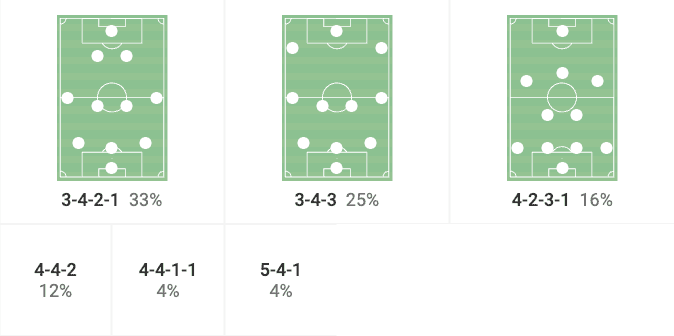
The potential line-up, structured in a 3-4-2-1 formation, could feature Lukas Hradecky in goal, guarded by a defensive trio consisting of Jonathan Tah, Odilon Kossounou, and Edmond Tapsoba. The midfield may see Alejandro Grimaldo, Exequiel Palacios, Granit Xhaka, and Jeremie Frimpong, while the attacking duo might comprise Jonas Hofmann and Florian Wirtz supporting Victor Boniface up front.
Stuttgart’s build-up
Injuries compelled Stuttgart to adopt a back three in their recent games. However, for the latest match, Hoeneß has reverted to a four-man defence to fortify the foundation for the front two. This adjustment involves Maximilian Mittelstädt returning to a conventional left-back position and Pascal Stenzel taking on the right-back role, especially with Hiroki Ito injured until next year.
Hoeneß has strategically leveraged Stenzel’s background as a central midfielder in his youth and acknowledged Mittelstädt’s poise on the ball in central areas. As a result, both full-backs frequently drift infield alongside the midfielders, a role Stenzel had previously performed at the start of the season before his injury. On the left, Ito had been less prone to moving centrally, usually sticking to the wing in a back four or on the left side of a three.
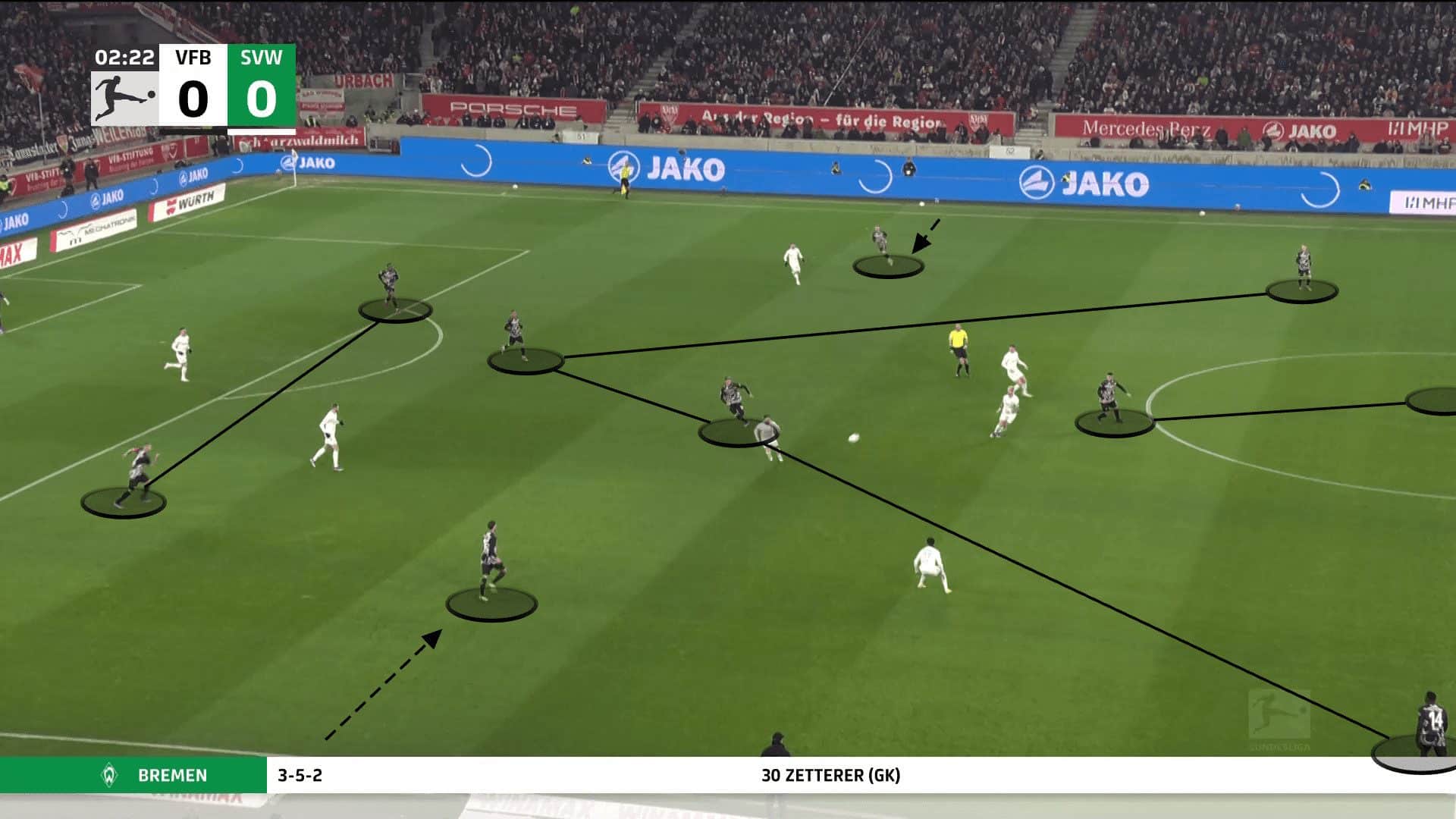
The tactical adjustment stemmed from the choice to substitute holding midfielder Angelo Stiller, opting to replace him rather than No.10 Enzo Millot, thereby making way for the second striker. Millot took on a slightly deeper position, but Hoeneß’s strategic deployment of full-backs moving infield, particularly alongside Atakan Karazor, provided defensive solidity and enabled Millot to assume a more active role in the attacking play.
Goal Threats
Undav first played a crucial role as the second striker positioned between the lines. However, when he shifts alongside Guirassy, it creates space and allows Millot more freedom in the attacking midfield role.
The dynamic between the two forwards resembled a classic pair of center-forwards. Guirassy primarily operated as the target man, positioned furthest forward and closely marked by the defence. He often drifted to the left but maintained a central presence. On the other hand, Undav had a multifaceted role – dropping between the lines to link play and then making runs in behind, especially when Guirassy moved deeper. This tactical coordination placed him frequently on the right of the centre.
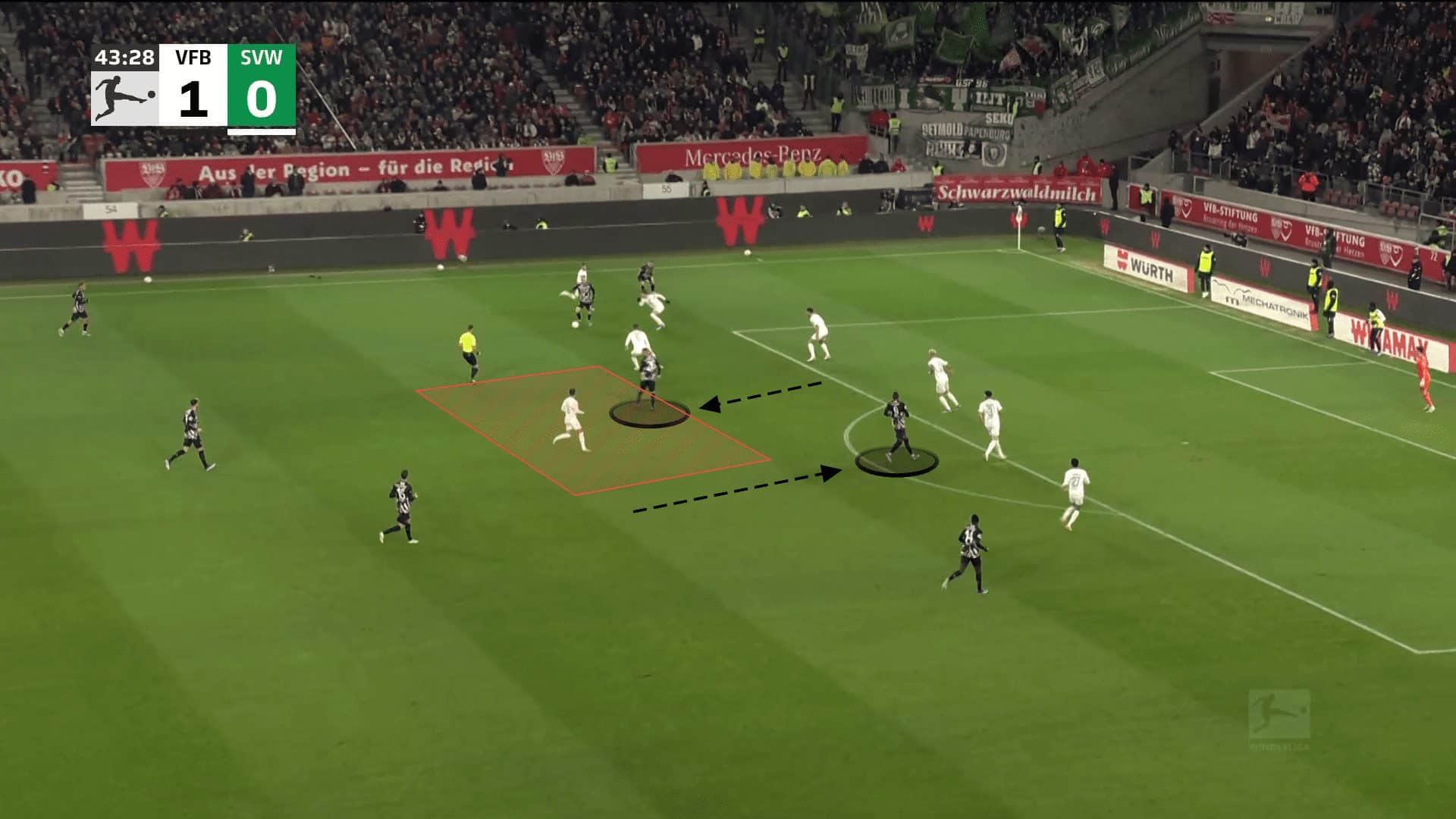
A big advantage of this formation is that the four narrow midfielders can quickly apply pressure when possession is lost. When Stuttgart then win the ball back, they are able to get forward quickly.
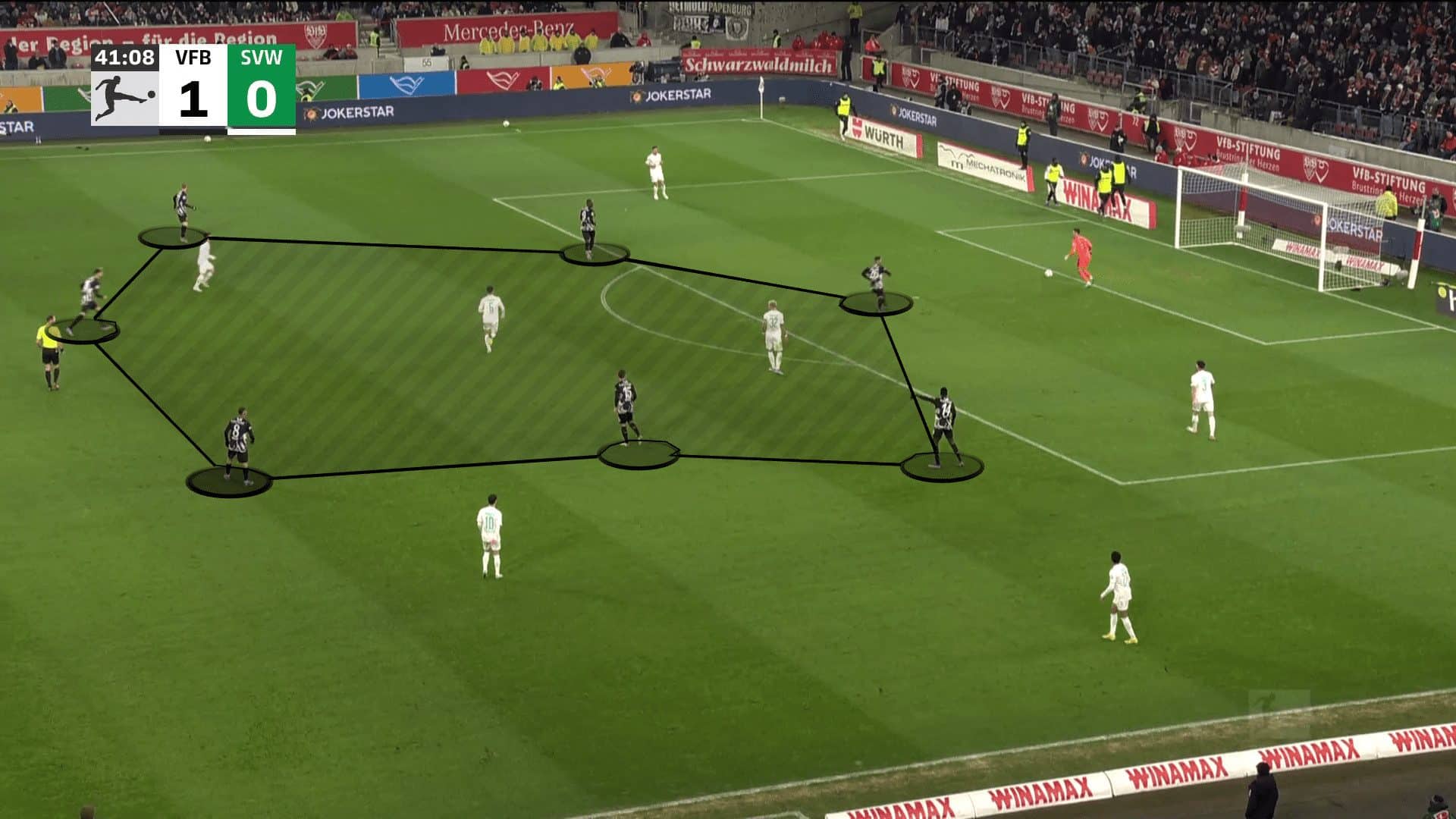
Bayer Leverkusen’s build-up
However, executing an effective gegenpress against Leverkusen could prove to be a challenging task given their proficiency in build-up play. The statistics from last season, where Bayer averaged 51% possession, might be somewhat misleading as Seoane took charge in the initial months. However, this season, Leverkusen has significantly increased their possession, currently standing at 58%, trailing only behind Bayern Munich. What’s more impressive is their exceptional passing accuracy, leading the league with a remarkable 90% completion rate.
Even when focusing on final third passes, typically more challenging due to the need for precision, Leverkusen’s pass ratio only slightly drops to an impressive 89%. This showcases their ability to maintain composure and accuracy even in high-pressure areas, making it a formidable challenge for Stuttgart to effectively gegenpress and disrupt their build-up play.
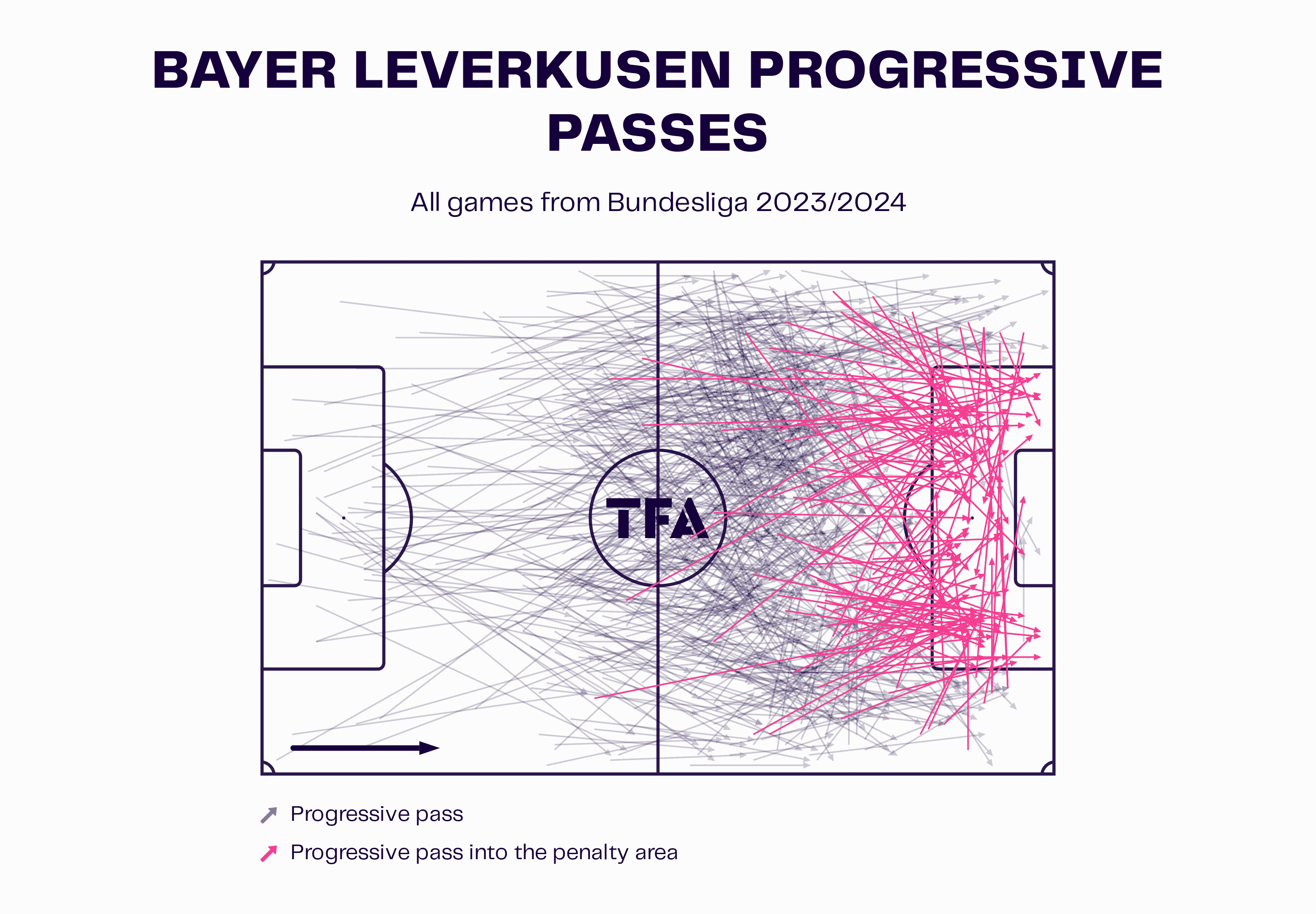
Leverkusen’s wing play
In essence, Leverkusen operates in a 3-4-2-1 formation where each player understands their designated roles. The central area of the pitch is densely populated. The wide players’ high positioning during possession allows the dynamic wing-backs to surge forward with pace. However, their tactical intelligence shines when they lose possession, swiftly retreating to positions around the halfway line.
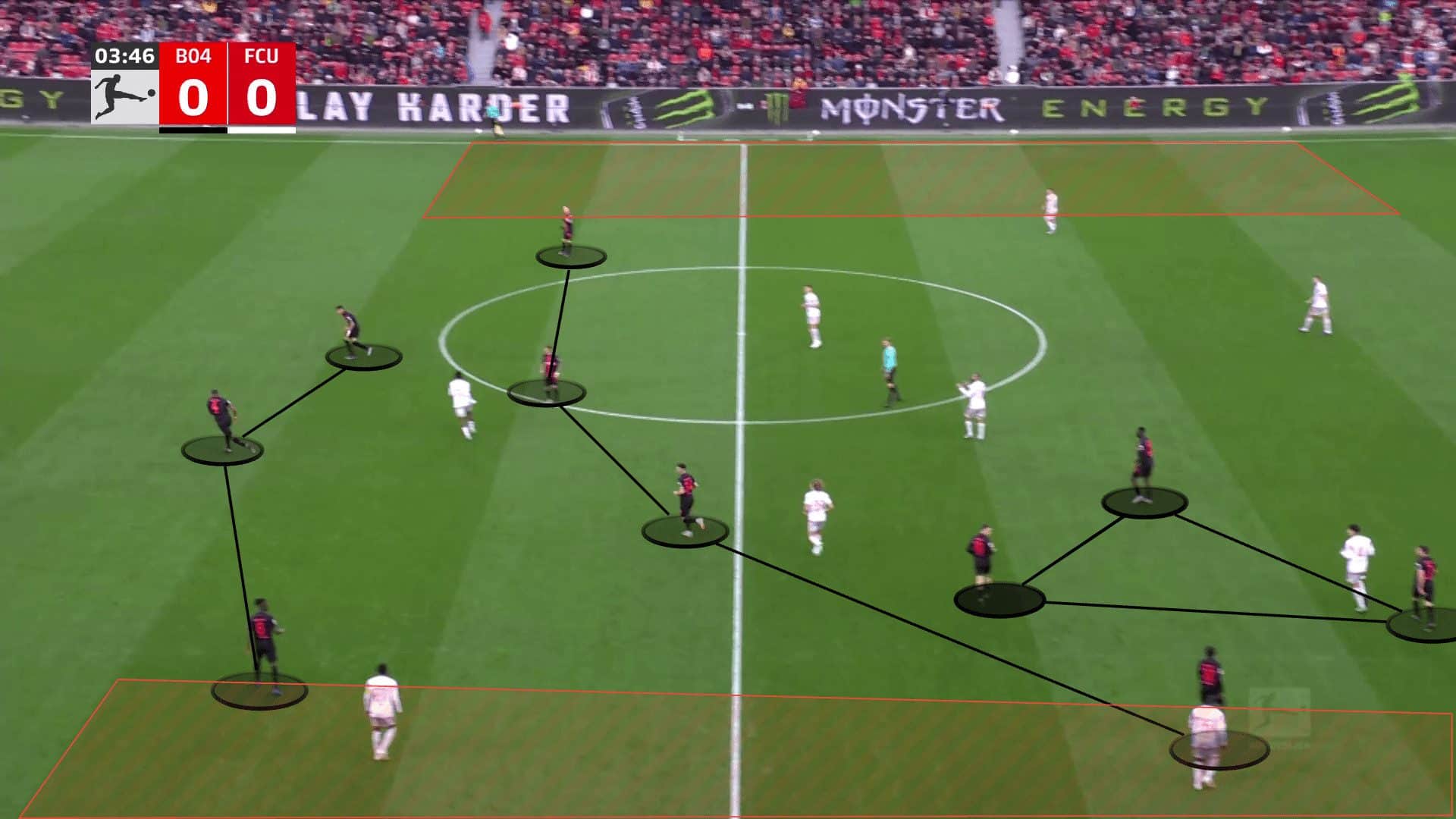
What sets Leverkusen apart is the well-distributed attack across various zones. Statistics from their Bundesliga matches indicate a balanced distribution: 29% down the left flank, 20% in the inside-left channel, 18% in the inside-right channel, and 33% down the right. This even distribution poses a significant challenge for opponents, as focusing on one area leaves other channels open for potential threats, making Leverkusen’s attack a multifaceted and unpredictable force.
Chance Creation
The crux of Leverkusen’s goal creation lies centrally, orchestrated by players like Wirtz, Hofmann, Xhaka, and Palacios, who adeptly thread passes and identify the well-timed runs of the wingers. Remarkably, a significant portion of their 38 goals, precisely 24 of them, originates from the heart of the pitch, constituting an impressive 65%, positioning them as the third-best in the league in this aspect.
In contrast to traditional wing play centred around crosses, Leverkusen’s wide players often seek goal-scoring opportunities themselves, exemplified by Grimaldo’s seven goals and Frimpong’s four.
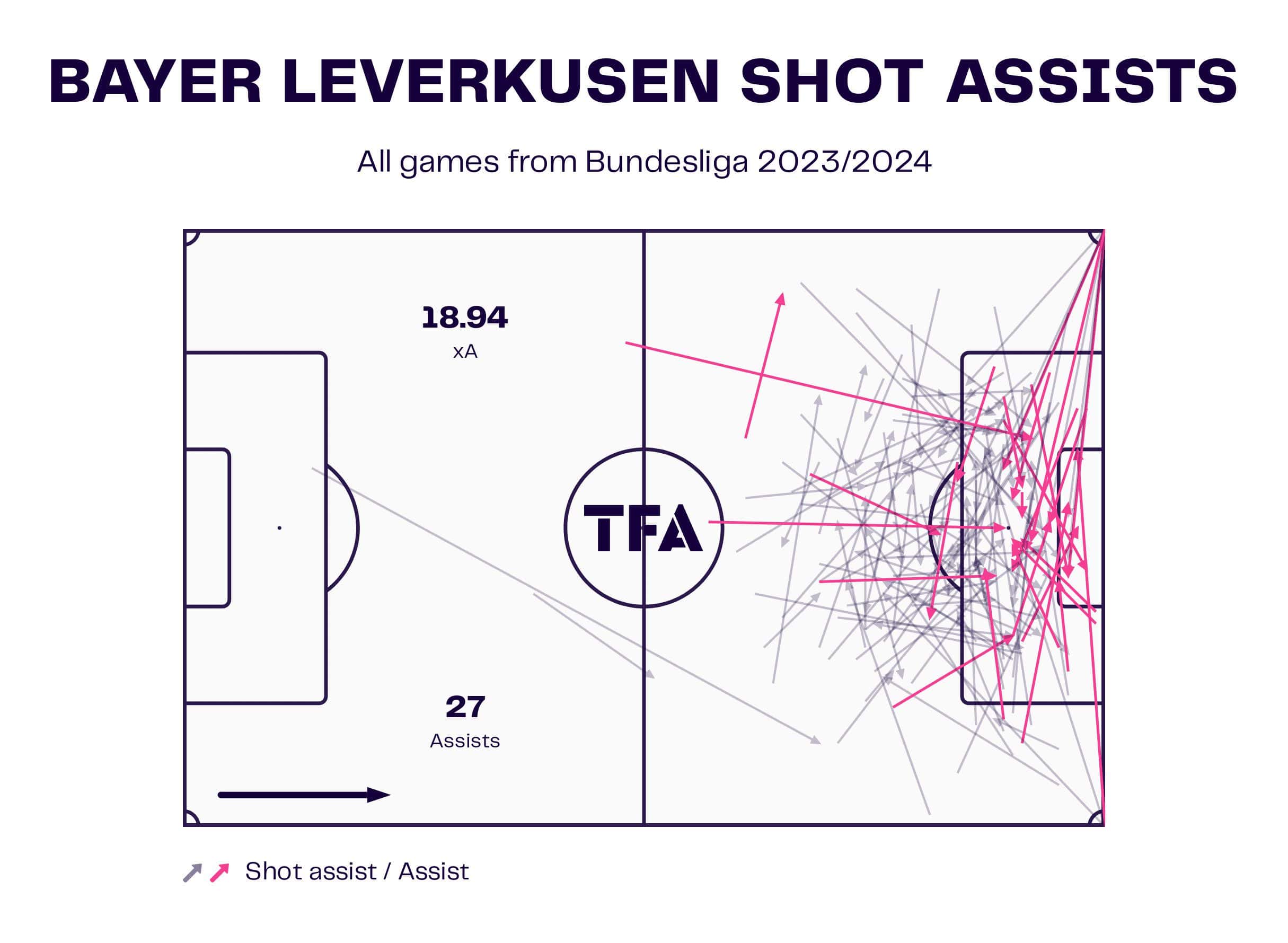
This strategic approach might pose challenges for Stuttgart’s defence, especially considering their vulnerability in conceding goals from open play in the central areas, accounting for 62% of their shots against. The dynamic interplay orchestrated by Leverkusen’s central creators could exploit this defensive vulnerability, making it a key aspect to watch in the upcoming match.
Set-Pieces as the key
In what promises to be a closely contested match, the outcome might hinge significantly on set-pieces. Set-pieces have been a vulnerability for Stuttgart, accounting for 13% of the goals they’ve conceded this season. While Stuttgart has found the net only once from a set-piece, Leverkusen stands out for its proficiency in attacking set-pieces.
Although Leverkusen excels in dynamic open play, their prowess in set-pieces adds an extra dimension to their strategy. With Xabi Alonso, a former free-kick maestro, at the helm, set plays retain their importance for Leverkusen. The team has netted eight goals from set-pieces, encompassing four corners, two free-kicks, and two penalties, establishing another Bundesliga high this season. In closely contested matches, when the margins are fine, capitalising on set-pieces can often prove decisive, providing Leverkusen with a strategic advantage in potentially pivotal moments.
Conclusion
Stuttgart’s recent tactical adjustments, reverting to a four-man defence, signal a calculated move by Hoeneß to fortify the team’s foundation, particularly in support of the front two. The strategic use of full-backs tucking infield, coupled with the fluidity of Enzo Millot, adds a dynamic element to Stuttgart’s attacking play.
Leverkusen, under Alonso’s guidance, showcases a well-drilled 3-4-2-1 formation with defined roles and exceptional fluidity in their attacking zones. The wide men, exemplified by Alejandro Grimaldo and Jeremie Frimpong, contribute significantly to Leverkusen’s attacking diversity, pulling opponents in different directions.
The tactical battle intensifies in midfield, with Leverkusen’s quartet of Wirtz, Hofmann, Xhaka, and Palacios orchestrating attacks centrally. Leverkusen’s prowess from set-pieces, orchestrated by Alonso’s experience, could prove pivotal, especially in a closely contested encounter.
The analysis sets the stage for a riveting contest, where the tactical acumen of the coaches, the strategic adjustments, and the ability to capitalise on set-piece opportunities could be decisive. As the teams step onto the pitch, the fans can anticipate a high-stakes duel where every tactical nuance may shape the outcome of this Bundesliga showdown.





Comments